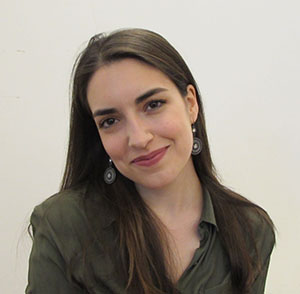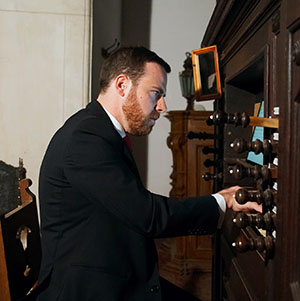|
Sunday mass The greater part of music involving the organ was conceived for liturgical purposes. As other artists at the Madeira Organ Festival have done in preceding years, the organist Sérgio Silva and the soprano Cecília Rodrigues will collaborate at the Sunday Eucharist. Religious music from Portugal and England (specifically that of Edward Elgar, himself a Catholic) can be heard in the context for which it was written. |
Participants
|
Cecília Rodrigues began studying the piano at the IGL, and later vocal technique with Elsa Cortez at the same school. At the age of 18 she went to the EMCN, where she studied singing with Manuela de Sá. She continued her studies at the Higher School of Music in Lisbon, where she is currently completing a masters in music education with Luís Madureira. She has worked with Lucia Mazzaria, Milagros Poblador, João Paulo Santos and David Santos, and she works regularly with the baritone Luís Rodrigues. She has won the 2013 Prize for the performance of Portuguese music in the City of Fundão International Competition; the First Prize and Prize for the performance of Portuguese music in the City of Almada International Competition 2015; and the First Prize in Singing in the Youg Musicians’ Prize, Radio 2 – RTP. She appeared as a soloist in the “Sons da Água” festival in 2016 and 2017, under the direction of António Costa. She collaborated with the Olisipo Vocal Group in a concert dedicated to Monteverdi at the Belém Cultural Centre, and gave a recital with João Paulo Santos in the Serões Musicais festival at the Pena Palace in Sintra, later recorded for Radio 2. She sang Bess, from Porgy and Bess by Gershwin, in the Música no Colégio festival 2018, with the Coral São José, Ponta Delgada. She was a member of the Choir of the Casa da Música and is a member of the Gulbenkian Choir, with which he has performed as a soloist in a concert of music by Gershwin, and in Bach’s St Matthew Passion. |
|
Holding a masters degree from the University of Évora, Sérgio Silva began studying organ at the Gregorian Institute of Lisbon under João Vaz, and accompaniment and improvisation under António Esteireiro. In addition, he had the opportunity to work with a number of organists of international renown, such as José Luis González Uriol, Luigi Ferdinando Tagliavini, Jan Willem Jansen, Michel Bouvard, Kristian Olesen and Hans-Ola Ericsson. As a concert performer, he appears regularly both as a soloist and a member in a number of prestigious Portuguese ensembles, and has performed in Portugal, Spain, Italy. Great Britain, France, Germany and Macau. As a researcher, he has made a number of transcriptions of early Portuguese music. He currently teaches organ at the Gregorian Institute of Lisbon and at the Lisbon School of Sacred Music, and is titular organist of the Basilica of Estrela and of the Church of St Nicholas in Lisbon. |
Notes about the organ
 Sé do Funchal (Choir organ)
Sé do Funchal (Choir organ)
Dinarte Machado, 2017
The new choir organ of Funchal Cathedral is the result of a project organized by the Chapter of the Cathedral, to endow the building with an instrument essentially intended for the current needs of the liturgy, but at the same time appropriate for recitals and other events outside the context of the liturgy. The organ was installed in the south transept, next to the altar and the choir (emphasizing its eminently liturgical vocation), but it can be turned on a central axis and face the central nave.
The case, designed by the organ builder Dinarte Machado, is the result of a free interpretation of the ogival arches of the Cathedral and the majority of the decorative elements refer to religious elements (names of saints) or traditional themes (wicker baskets).
The organ, the final version of which was the result of discussions between the organ builder and the Choir master of the Cathedral, Fr Ignácio Rodrigues, has sixteen registers, spread over two keyboards and a pedalboard. The voicing of all these registers took into account not only the instruments multiple functions, but above all the acoustics of the church.
The phonic conception is very original, not being inspired by any similar instrument, or identified with any period or style. It was intended that, by using its timbral diversity and exploring its capacities, organists could use the instrument in repertoires from many different periods and by many different composers, as well as to encourage contemporary composers to write new works. This was the vision of its builder, Dinarte Machado, who considers that the organ “offers every freedom to the organist as improviser”.
I Manual – Great organ (C – g’’’)
Flautado 12 aberto [8’]
Flauta em 12 [8’]
Oitava real [4’]
Quizena [2’]
Mistura III vozes
II Manual – Swell organ (C – g’’’)
Flautado 12 tapado [8’]
Viola da gamba [8’]
Flauta de chaminé [4’]
Dozena [2 2/3’]
Quinzena nazarda [2’]
Dezassetena [1 3/5’]
Dezanovena [1 1/3’]
Clarinete [8’]
Pedal (C – f’)
Flautado de 24 tapado [16’]
Flauta [8’]
Baixão [16’]
Couplers
I - P
II - P
II - I
 Sunday, October 21, 11.00 am
Sunday, October 21, 11.00 am Cecília Rodrigues
Cecília Rodrigues Sérgio Silva
Sérgio Silva